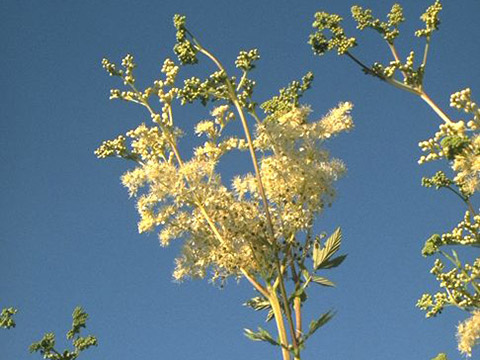Botanical name
Filipendula ulmaria (L.) Maxim. (Syn. Spiraea ulmaria L.)
Family
Rosaceae
Common name
Mead wort, Queen of the meadow, Pride of the meadow, Lady of the meadow
Information about the plant
Meadowsweet is widespread throughout the temperate northern zone. It can be found from northern Siberia, the Altai, and eastern Mongolia to Anatolia, as well as throughout Europe, except in the far south. It grows on wet, nutrient-rich soils, such as peat soils, wet meadows, alluvial forests, and along ditches or streams.
Linné classified the plant as a species of the genus Spiraea (spirea), which is why the synonymous name Spiraea ulmaria L. is still used in books today. This is also the origin of the formerly common drug name “Spiraeae herba” or “Spiraeae flos”. Specific characteristics, such as the number of carpels and a higher number of seeds, have led to the formation of a separate genus Filipendula, which can be confirmed biochemically and cytologically.
Meadowsweet is a 50 to 150 cm tall perennial. The long-stemmed, odd-pinnate leaves are alternate; the individual leaflets are 2 to 8 cm long and double serrated, and the terminal leaflet is large and three-lobed. The small, creamy-white and highly fragrant flowers are numerous and arranged in terminal corymbose racemes or panicles with multiple rays. The flowering time is from June to August.
The genus name Filipendula is derived from the Latin 'filum' (= thread) and 'pendulus' (= hanging) referring to the bulbous thickenings hanging from the thin root fibers of the dropwort (F. vulgaris). The species epithet ulmaria refers to the similarity of the leaflets to the leaves of the elm tree (Latin 'ulmarius' = elm-like). The German name 'Mädesüß' can be explained as a “plant that grows in meadows (mowing) and has a lovely scent”. The flowers do indeed have a strikingly sweet scent. If the flowers are rubbed - including the stems and leaves - with the fingers, the smell becomes increasingly “synthetic”. This is due to the methyl ester of salicylic acid contained in the plant.
Salicylic acid was first isolated from meadowsweet flowers by Karl Jacob Löwig in 1853 and was called “spiric acid” at the time due to its origin from Spiraea ulmaria. The bitter and mucous membrane-irritating spiric acid (= salicylic acid) was initially used in gram doses to treat rheumatoid arthritis, but the molecule was later chemically modified to make it more effective and better tolerated. The breakthrough came in 1897 when Bayer synthesized acetylsalicylic acid, which has now been successfully marketed as Aspirin® for over 120 years. The 'A' stands for 'acetyl', while 'spir' stands for 'spiric acid', the old name for salicylic acid.
Medicinally used parts of plants (herbal drug)
The dried stem tips collected at flowering time, consisting of flowers, stems, and leaves (meadowsweet herb - Filipendulae ulmariae herba), are used. As only the ends of the stems are harvested, the flowers dominate. The drug was, therefore, listed in the older pharmacopoeias as Flores Spiraeae or Spiraeae flos (meadowsweet flowers). If the drug consists only of flowers, the correct name today is Filipendulae ulmariae flos - meadowsweet flowers.
The commercially available drug is sourced from cultivations in Eastern European countries.
Constituents of the herbal drug
Meadowsweet herb/flowers contain phenolic glycosides (glycosides of salicylic acid methyl ester and salicylaldehyde), as well as flavonoids and tannins.
Quality of the drug
The quality of meadowsweet herb (Filipendulae ulmariae herba) is specified in the European Pharmacopoeia (Ph. Eur.). The quality of meadowsweet flowers (Spiraeae flos) is specified in the German Pharmacopoeia Codex (DAC).
Medical applications
Recognised medical use
The HMPC has classified meadowsweet herb and meadowsweet flowers as traditional herbal medicinal products (see “Traditional use”).
ESCOP: Meadowsweet herb: supportive therapy for common colds; enhancement of renal water excretion (not scientifically proven).
Traditional use
Meadowsweet herbs and meadowsweet flowers have been classified by the HMPC as traditional herbal medicinal products (Article 16a of Directive 2001/83/EC). Based upon long-standing use, meadowsweet herb/flowers can be used as a supportive treatment for common colds and minor aches and pains.
Herbal drug preparations in finished dosage forms
- Cut meadowsweet herbs or meadowsweet flowers for tea preparation.
Dosage
Finished medicinal product: see patient information leaflet.
Tea: Drink a cup of meadowsweet herb tea or meadowsweet flower tea several times a day; daily dose 2 to 18 g meadowsweet herb, 2.5 to 6 g meadowsweet flowers. A combination with other drugs, e.g. lime blossom, elderflower, and chamomile flowers (cold tea), is advised.
Preparation of a tea
Pour approximately 150 mL of boiling water over 3 to 6 g of chopped meadowsweet herb or 2 to 4 g of meadowsweet flowers and strain after 5 to 10 minutes.
Notes
Meadowsweet herbs and meadowsweet flowers must not be taken in case of hypersensitivity to salicylates (e.g. Aspirin®).
No safety studies are available on the use of meadowsweet herbs/flowers during pregnancy and lactation. Use in children and adolescents under the age of 18 is not recommended due to a lack of evidence.
Side effects
None known.
Interactions
None known.
References
Herbal drug monographs
HMPC (2011, 2020), ESCOP (2016)
Further literature
Commentary on the European Pharmacopoeia (Meadowsweet herb, No. 1868)


